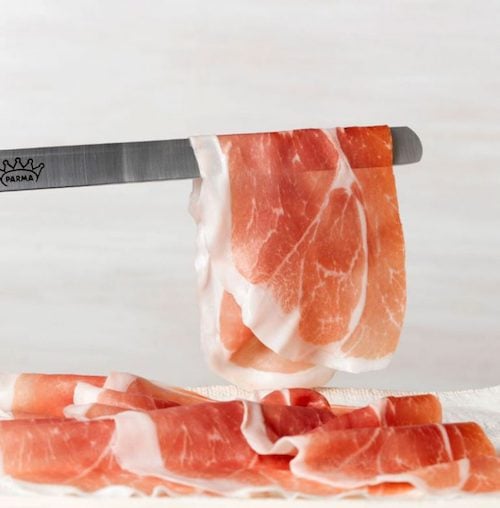Storage & Care
Taking care of the product can extend its shelf life and preserve the flavor of Prosciutto di Parma for months after purchase.
The minute you receive your Prosciutto di Parma
- The first step is always to check the tags and labels and confirm the product is indeed Prosciutto di Parma.
- Then, regardless if it’s a bone-in or boneless leg, it should be immediately refrigerated in its original packaging.
- Refrigeration is necessary, especially in warmer environments. Because kitchens can get warm quickly, it’s best to get the legs into a cooler temperature to avoid getting soft.
- Note: bone-in legs will only continue aging if they’re not refrigerated.
- A vacuum-packed leg is best if used within 12 months of deboning, refrigerated at 40°F to 45°F. Once the vacuum seal is broken and slicing begins, the ham can be held under refrigeration for up to two months.
- Note: NEVER place a leg of Prosciutto di Parma in a freezer. Prosciutto di Parma cannot be frozen because it causes the moisture to expand. When it thaws, the moisture dissipates, causing the leg to become too soft and losing its flavor.
When you open the Prosciutto di Parma
- A bone-in leg may have mold when it arrives.
- Don’t worry – this is normal and a natural part of the curing process. If you notice mold on the leg, wipe it off using a mixture of water and sea salt.
- Bone-in legs can be shipped in plastic or without (because it is a live product and still curing). If it arrives in plastic, we recommend you dry it for at least a week before using it.
- Contact your supplier if your boneless leg has mold. It may be due to oxygen penetration from damage to the cryovac packaging and loss of vacuum.

How to maintain Prosciutto di Parma
- With both bone-in and boneless legs of Prosciutto di Parma, requirements for maintaining the product are similar. Regardless of how long you are using the product, it is recommended that you wrap the leg in plastic wrap and keep it refrigerated during service and in between uses.
- It is important to keep Prosciutto di Parma legs away from strong aromas like onions, which can affect the flavor. It is also critical that the legs are kept away from the oven and hot surfaces. If the leg reaches a warmer temperature and then cools back down, it can become rancid.
- A boneless leg can last up to two months if properly handled and maintained while in use.
- A bone-in leg doesn’t have as many restrictions with storage as a boneless leg because it has usually been cured longer.
- You can leave a bone-in leg outside for service time for five hours, and then put it back in the refrigerator, as long as it’s away from the oven or hot surfaces.
- The longer the leg has been cured, the longer it can stay outside of the refrigerator.
- To preserve the leg longer, remember to keep the outer layer of skin that you removed when you were prepping the leg for slicing. In between uses, cover the exposed part of the leg from which you were slicing with this piece of skin, wrap the entire leg in plastic wrap, and put it back in the refrigerator. When you’re ready to slice again, take the skin back off, storing it in the refrigerator until the leg is ready to be put away, and remove the first slice from the leg and discard. Now you’re ready to start slicing again. Repeat these steps until you finish the leg (or it’s past its shelf life).

